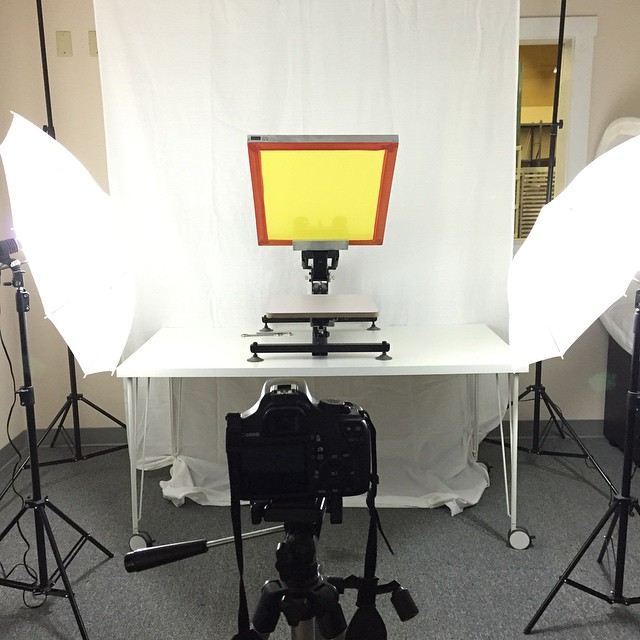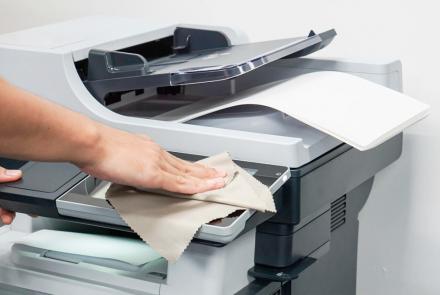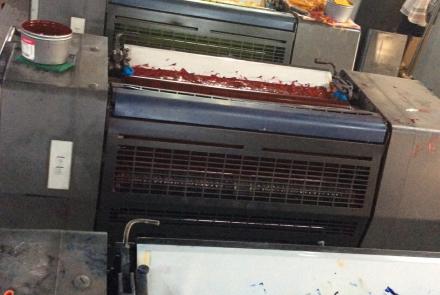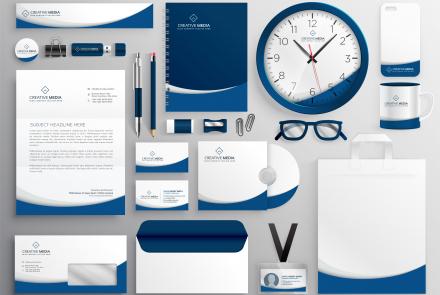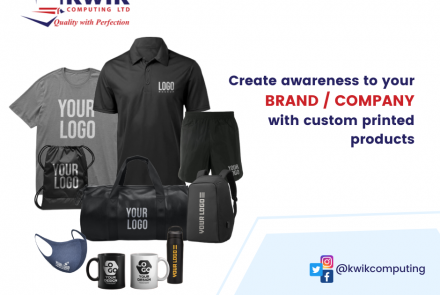It Takes A Village To Print A Shirt
In this video, you will see 1909 shirts printed in one hour — a pretty amazing feat, really, but. M&R claims in the very first frame that this was accomplished by “1 Operator.” Let’s break that down by what we actually see in this video and look at what it actually took to print this (admittedly fantastic) number of shirts.
I’ll preface this first of all by saying that M&R really does make great equipment — I’ve printed exclusively on their automatic presses since I bought my very first auto in ’93. The Challenger III is a serious piece of kit — I’ve only seen one in action, but they’re fantastic machines that turn really, really fast. Each generation, M&R has done a great job of carefully analyzing the shortcomings of their previous presses and re-engineered them in inventive & smart ways. I had a long laundry list of things I wished were better about my series I machines by the time I’d been working on them for 10 years, and when i got my hands on a Challenger II, I can tell you that M&R fixed every single one of those shortcomings. I haven’t yet spent any time operating a Challenger III but I’d imagine that they’ve done the same to improve it over the II series, from the looks of them, and the list of new features.
That said, let’s look at our operator in this video, and let’s look at his help. Right off the bat, you can see that there’s not one person loading the shirts — there’s actually three. Once he starts running, there are two people to his right opening up the shirts at the hem & getting it ready for him to grab, & make sure it comes neatly off the pile without grabbing the shirt beneath it. Behind them, is yet another helper, getting more shirts ready & helping to slide the just-right-sized piles towards our Lone Operator. So, at this point, we have four people involved in getting the shirt on the press. Even with all this help, you can’t help but note that running at this speed, this shirts aren’t going on the machine exactly straight. Watch some of the overhead shots where you can see the collar after it turns to the right of him. Speed is great, but it ain’t everything. Prints have to be right, too. Again I don’t mean to disparage this athletic feat, but quite a few of those shirts are more than an inch or two off-center. Explain that to your client when they pick up. At the end of the video, they claim 26 rejects, but if they docked him the rejectable prints due to centering on a stricter basis, I’d bet the final number would drop below 1700.
Let’s now look at getting the shirt off the press. Normally, there is a person standing at the un-loading station, pulling the printed shirt off the machine & placing it on the conveyer belt to go through the curing oven. In place of this person, we can see that M&R has positioned a device they call The Passport, which is supposed to eliminate the need for this human puller.
I will parenthetically contend that even with the labor savings this is a bad idea, because it eliminates you first point of quality control. Absent a pair of eyes at the unloading station, print defects aren’t going to be seen for another 20 shirts, when they emerge from the oven at the end of the conveyor. If a machine can print fast, take it from me by way of hard experience, a press can also print rejects at a dismaying pace.
That’s not the only reason I take issue with the Passport, though. I’ve seen three of these devices out in the field, and none of them were being used. Rather, they were either (1) sitting on the floor beside the press after the company gave up on it, or (2 & 3) actively inhibiting the operation of the machine, as the printers resorted to elaborate work-arounds to get shirts off the machine without having to resort to the Passport. One guy was loading 14 shirts onto his press, then RUNNING around to the last print head, and pulling the shirts off out from under the flipped-up front screen bracket before they got to the Passport, & ferrying each one three steps to the dryer, then when the press was cleared, running back around to load another 14 shirts onto the press. He was effectively running at less than half the speed he would have been running at if the Passport had not been in his way & he had a helper. His succinct words were “It doesn’t work.” Another shop had arranged an “ergonomic” method where two people would work at the loading station — one would unload the shirt and rapidly step out of the way, while the other stepped in to load a shirt, then he in turn would rapidly step out of the way so that the next shirt could be in turn unloaded. It was a complicated, cramped ballet that enabled them to run the machine at almost 3/4’s of the speed it would have normally run at, if the Passport hadn’t been idly occupying the unloading station. Their words again were (paraphrased) “It tears shirts, it drops them in a heap on the belt & they don’t cure & get smeared, it misses shirts, it doesn’t work very well.”
How, then, is the Passport in this video performing so spectacularly, you might ask? That brings us to the 5th person helping to print this run of shirts. See the guy in the video hovering to the left of the Passport with the aerosol spray tack can in his hand, carefully monitoring the Passport & carefully applying a small amount of tack as needed? That is none other than Rich Hoffman himself, the CEO of M&R. I posit that if you need the CEO of the company to monitor your labor saving device for each & every shirt, it’s not exactly saving you labor. I’d imagine Rich’s time is worth a bit more than you average press assistant’s. From what I’ve seen, the Passport is for all intents and purposes, a rare failure as a product.
Now, let’s also note the design they’re running, here. It looks to be of average size, but despite being a five color print, there is actually very little ink deposit. It seems like the design was created specifically for this reason — to appear to fill up the shirt, but to have very light tack requirements, so that the Passport wouldn’t have to struggle to get the shirts off the press. Another benefit here is that during the hour they ran the machine, it does not appear that anyone had to load ink into a screen. It’s possible that they edited this out, and though it’s a thing that can usually be done on the fly without stopping a press, it’s yet a sixth person you’d need if you were printing a design that was, say 10 X 12 with 100% ink coverage in that area. The print we see here might appear to be 8 X 10 overall, but I’m betting that no more than 15% of that area is actually covered in ink. M&R very carefully set the stage design-wise with two things in mind here — less need to load ink into the screens during the run, and less need for tack so that the Passport could successfully get the shirts off the press, albeit with the help of M&R’s (hopefully) highest-paid and most important staff member.
Really, in the end, my complaint about this video is not that M&R didn’t successfully print 1909 shirts in an hour — it’s that it actually took 5 or perhaps 6 people to accomplish this feat, and it was still a hell of a feat for all of those involved. Yes, only one person is seen “operating” the machine I.E. Luis Omar Viera was the only person who touched the control panel, but to say that one person did this is disingenuous.
It creates a level of hype that’s impossible for people to realize under real world circumstances, and leads to disappointment when after you’ve uncrated & set up your fabulous new machine, your 3-person crew is really only averaging 600 or 700 shirts an hour, because you can’t sprint a marathon, & not all your clients are going to design prints that are optimized for speed — clients want what they want, & if it takes a double stroke & you have to tack every 4 dozen shirts & load ink every 6 dozen shirts to give them what they want, then that’s what you’ve got to do. An old Challenger I will turn 1000 times an hour if you set it up right, & I have actually gotten 1000 prints off of one in an hour, just to say I could do it, back in about ’94. It was a 1-color left-chest print that was a tiny line of text, & at the end of the hour, I was exhausted, & had to go sit down for 15 minutes. I haven’t tried that since.
All thanks to M&R for continuing to make an excellent product, but take this thing with the grain of salt it deserves, and let’s give credit to everyone in the village who helps print a quality shirt every day.
- Log in to post comments

